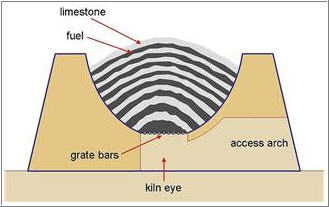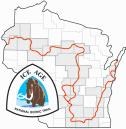IATCC - Pioneer Lime Kiln
Please note that this is an EarthCache and as such logging this cache requires special tasks be performed. Those tasks are detailed below. For this EarthCache you will need a camera and typical hiking supplies.
Trail expectations:
From the parking area you will see Oleson Log Cabin. A bit further along is the first of several signs which will direct you to the Pioneer Lime Kiln. Follow the trails (while keeping an eye out for the signs). You will travel on the Ice Age Trail as well as the John Muir Mountain Biking Trail (briefly). You should expect to walk about 1.8 miles round trip on a variety of terrain ranging from well blazed flat trails to slightly overgrown hilly terrain.
Be sure to leave your GPSs tracklog on and mark a waypoint at your car.
Pioneer Lime Kiln
You will be visiting a crude, circular lime kiln which was constructed by digging into the ridge and lining the pit with granite boulders. It is about 10 feet deep with granite walls and a clay floor.
The firing process
Simplified, a lime kiln is an oven used to produce quicklime by the "calcination" of limestone. Limestone is made up mainly of three components: calcium, carbon and oxygen. When limestone is heated the carbon escapes as carbon dioxide, leaving quicklime. This reaction takes place at approximately 750°F to 1,000°F. The heating and cooling process takes several days.
 Normally after limestone is fired it is cooled in cooling sheds and slaked. Unslaked quicklime is a volatile product, and it is essential that it be kept dry. When combined with water, it produces a violent, extreme heat-producing reaction. To make the product safe for transport and use the quicklime needed to be "slacked" (hydrated) under special conditions. Slaking involves adding moisture to the quicklime; this can occur in a number of ways such as carefully sprinkling it with water or letting it sit and absorb water from the atmosphere. During slaking the quicklime lumps will disintegrate to a fine powder. Other additives can be combined with the quicklime to create various products such as mortar for building. This kiln could only make small batches of quicklime and was likely used for only a few local settlers. Also due to the primitive nature of this kiln and the uneven heating it would have produced, the end product would have been best suited for the creation of fertilizer.
Normally after limestone is fired it is cooled in cooling sheds and slaked. Unslaked quicklime is a volatile product, and it is essential that it be kept dry. When combined with water, it produces a violent, extreme heat-producing reaction. To make the product safe for transport and use the quicklime needed to be "slacked" (hydrated) under special conditions. Slaking involves adding moisture to the quicklime; this can occur in a number of ways such as carefully sprinkling it with water or letting it sit and absorb water from the atmosphere. During slaking the quicklime lumps will disintegrate to a fine powder. Other additives can be combined with the quicklime to create various products such as mortar for building. This kiln could only make small batches of quicklime and was likely used for only a few local settlers. Also due to the primitive nature of this kiln and the uneven heating it would have produced, the end product would have been best suited for the creation of fertilizer.
The end days
In the early settlement days the lack of a good system of roads necessitated the production of lime wherever the raw materials were easily mined. As transportation and manufacturing methods improved during the 1900s commercial quicklime production began to spread throughout the state wherever limestone was plentiful. Later along with the introduction and availability of Portland cement, most lime kilns became obsolete.
The Niagara Escarpment
The limestone (calcium carbonate) found in this area is part of the Niagara Escarpment which continues northeasterly to the Door County peninsula and on to Niagara Falls. The limestone was formed by the settling and hardening of a limy ooze at the bottom of the shallow Silurian Sea which covered much of Wisconsin around 400 million years ago. This limy ooze was made up of shell and shell fragments consisting of corals, brachiopods, crinoids and other types of early life. Many marine organisms extract calcium carbonate from the seawater to make shells or bones and when these organisms die their shells and bones accumulate on the seafloor. Over millions of years these sediments harden into what we see today as limestone. Calcium carbonate is found naturally as a component of aragonite, calcite, chalk, marble and travertine.
|
Uses of Lime / Calcium Carbonate
|
|
As a filler in plastics
|
As an extender in paints
|
|
As an ingredient of cement
|
To treat animal hides and leather
|
|
In swimming pools as a pH corrector
|
In agriculture to improve acidic soils
|
|
In forensic science to reveal fingerprints
|
As a component of blackboard chalk
|
|
In adhesives, sealants, and decorating fillers
|
In water and sewage treatment to reduce acidity
|
To claim this EarthCache as a find:
1. Take and upload (optional) with your "found it log" a photo at the Pioneer Lime Kiln informational sign; include your team and GPS (or your GPS alone).
2. E-Mail me: Did you notice any limestone on your walk to the kilns? If so where? If not where do you think it could be found?
3. E-Mail me: Based on the geology of the Kettle Moraine, why did the builder choose the spot on the hill to place the kiln?
|
 IATCC is the cache designation to highlight a series of EarthCaches along the Ice Age National Scenic Trail grouped into a special category called "ColdCache." IATCC is the cache designation to highlight a series of EarthCaches along the Ice Age National Scenic Trail grouped into a special category called "ColdCache."
The Ice Age Trail is one of eleven (11) National Scenic Trails designated by the National Park Service. This unique trail is entirely within the state of Wisconsin and follows along the terminal moraine of the most recent glacier.
This project is supported by the Ice Age Trail Alliance. The goal is to bring more visitors to the trail and promote public awareness, appreciation, and understanding of Wisconsin’s glacial landscape.
More information on the Ice Age Trail Atlas, the ColdCache Project and Awards Program is available at: http://www.iceagetrail.org/coldcache.htm.
|
The Geocache Notification Form has been submitted to Paul Sandgren of the Wisconsin DNR. Geocaches placed on Wisconsin Department of Natural Resouce managed lands require permission by means of a notification form. Please print out a paper copy of the notification form, fill in all required information, then submit it to the land manager. The DNR Notification form and land manager information can be obtained at: http://www.wi-geocaching.com/modules.php?name=Wiki&pagename=Hiding%20A%20Cache
;